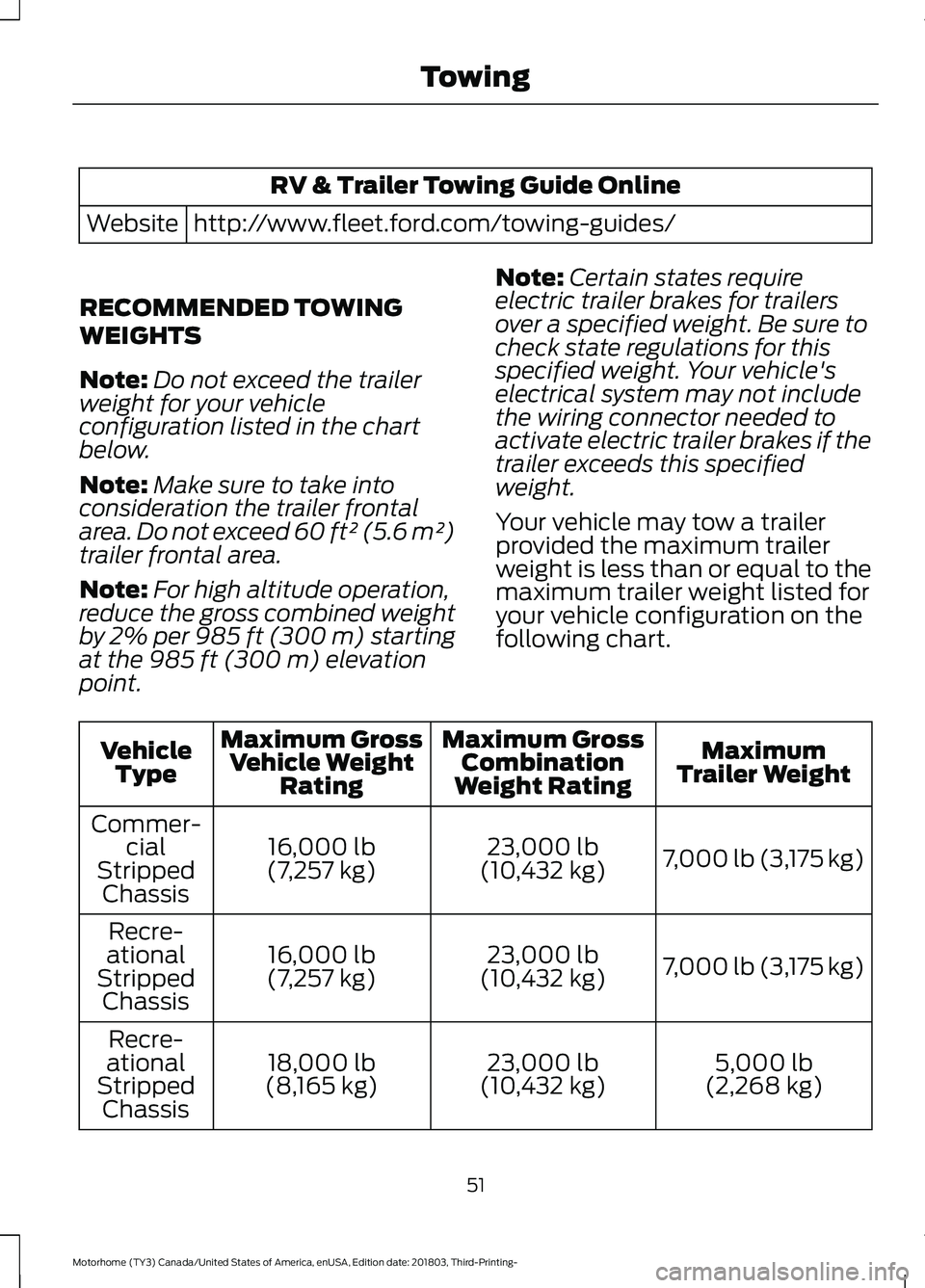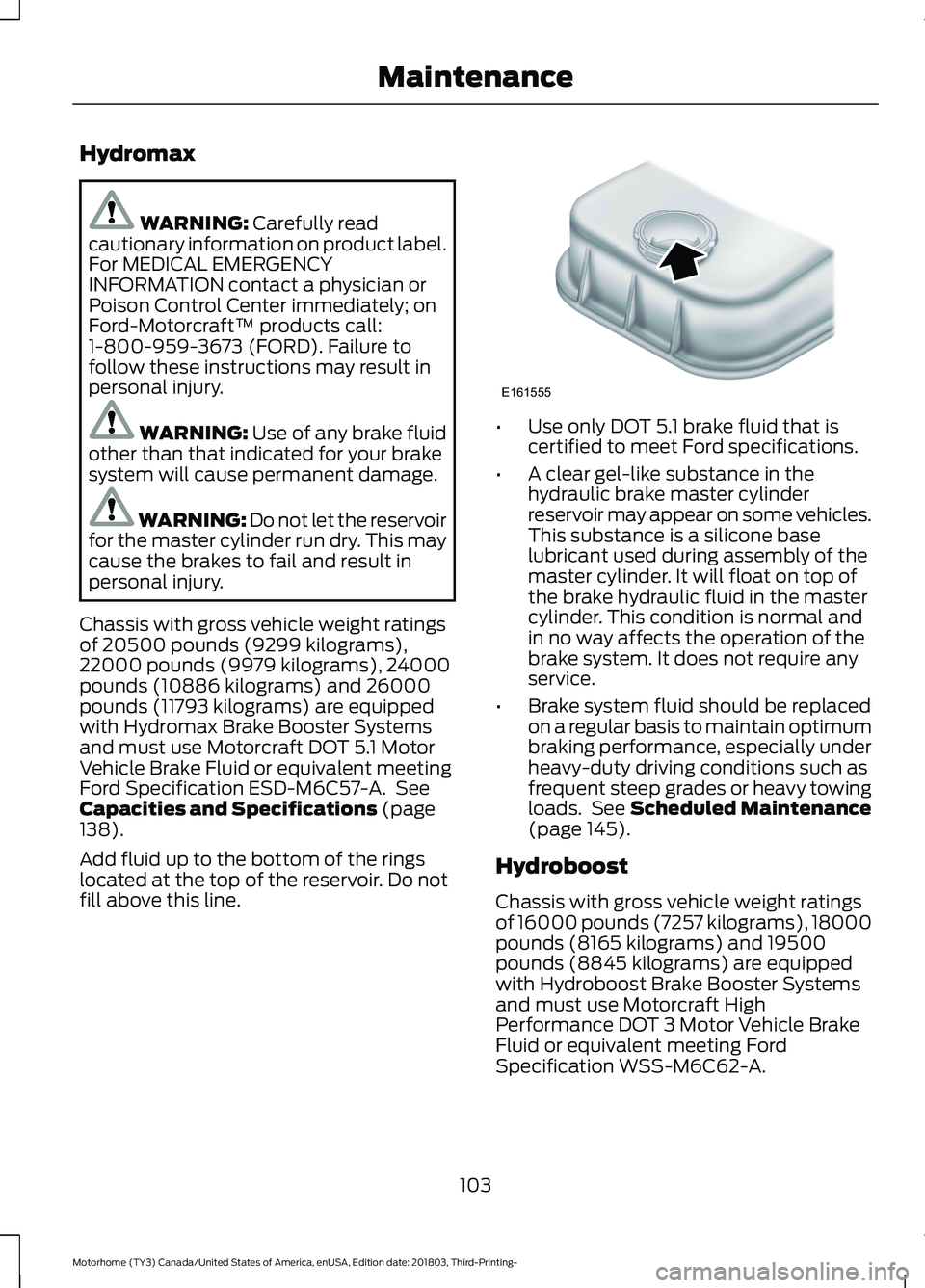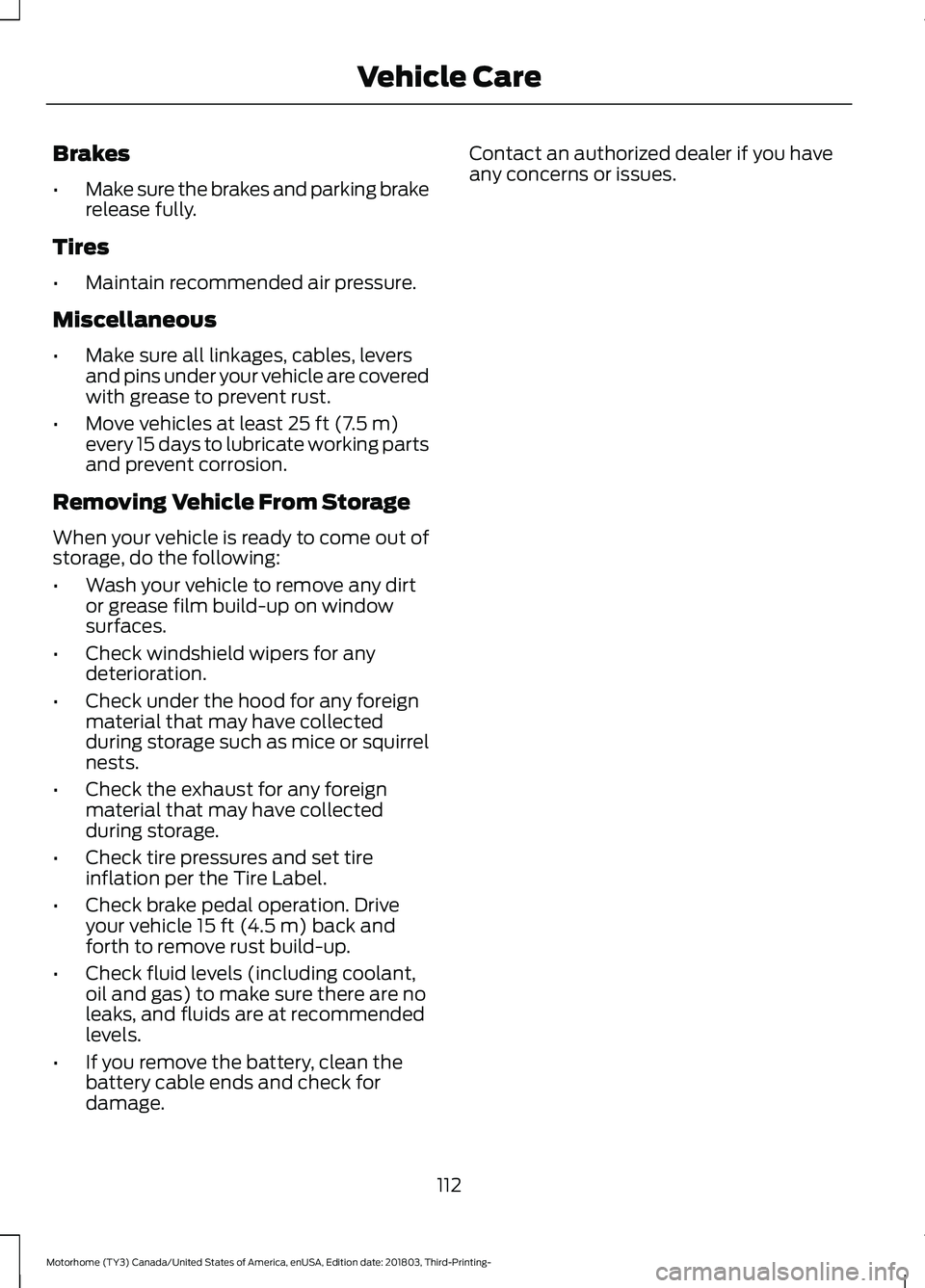2019 FORD F-53 brakes
[x] Cancel search: brakesPage 53 of 176

TOWING A TRAILER
WARNING: Towing trailersbeyond the maximumrecommended gross trailerweight exceeds the limit of yourvehicle and could result in enginedamage, transmission damage,structural damage, loss ofvehicle control, vehicle rolloverand personal injury.
WARNING: Do not exceedthe GVWR or the GAWRspecified on the certificationlabel.
Note: See RecommendedTowing Weights (page 51).
Your vehicle may have electricalitems, such as fuses or relays,related to towing. See Fuses(page 71).
Your vehicle's load capacitydesignation is by weight, not byvolume, so you cannot necessarilyuse all available space whenloading a vehicle or trailer.
Towing a trailer places an extraload on your vehicle's engine,transmission, axle, brakes, tiresand suspension. Inspect thesecomponents periodically during,and after, any towing operation.
Load Placement
To help minimize how trailermovement affects your vehiclewhen driving:
•Load the heaviest items closestto the trailer floor.
•Load the heaviest itemscentered between the left andright side trailer tires.
•Load the heaviest items abovethe trailer axles or just slightlyforward toward the trailertongue. Do not allow the finaltrailer tongue weight to goabove or below 10-15% of theloaded trailer weight.
•Select a ball mount with thecorrect rise or drop and loadcapacity. When both theloaded vehicle and trailer areconnected, the trailer frameshould be level, or slightlyangled down toward yourvehicle, when viewed from theside.
When driving with a trailer orpayload, a slight takeoff vibrationor shudder may be present due tothe increased payload weight.Additional information regardingproper trailer loading and settingyour vehicle up for towing islocated in another chapter of thismanual. See Load Limit (page45).
You can also find information inthe RV & Trailer Towing Guideavailable at your authorizeddealer, or online.
50
Motorhome (TY3) Canada/United States of America, enUSA, Edition date: 201803, Third-Printing-Towing
Page 54 of 176

RV & Trailer Towing Guide Online
http://www.fleet.ford.com/towing-guides/Website
RECOMMENDED TOWING
WEIGHTS
Note:Do not exceed the trailerweight for your vehicleconfiguration listed in the chartbelow.
Note:Make sure to take intoconsideration the trailer frontalarea. Do not exceed 60 ft² (5.6 m²)trailer frontal area.
Note:For high altitude operation,reduce the gross combined weightby 2% per 985 ft (300 m) startingat the 985 ft (300 m) elevationpoint.
Note:Certain states requireelectric trailer brakes for trailersover a specified weight. Be sure tocheck state regulations for thisspecified weight. Your vehicle'selectrical system may not includethe wiring connector needed toactivate electric trailer brakes if thetrailer exceeds this specifiedweight.
Your vehicle may tow a trailerprovided the maximum trailerweight is less than or equal to themaximum trailer weight listed foryour vehicle configuration on thefollowing chart.
MaximumTrailer Weight
Maximum GrossCombinationWeight Rating
Maximum GrossVehicle WeightRating
VehicleType
7,000 lb (3,175 kg)23,000 lb(10,432 kg)16,000 lb(7,257 kg)
Commer-cialStrippedChassis
7,000 lb (3,175 kg)23,000 lb(10,432 kg)16,000 lb(7,257 kg)
Recre-ationalStrippedChassis
5,000 lb(2,268 kg)23,000 lb(10,432 kg)18,000 lb(8,165 kg)
Recre-ationalStrippedChassis
51
Motorhome (TY3) Canada/United States of America, enUSA, Edition date: 201803, Third-Printing-Towing
Page 57 of 176

Trailer Brakes
WARNING: Do not connect atrailer's hydraulic brake system directlyto your vehicle's brake system. Yourvehicle may not have enough brakingpower and your chances of having acollision greatly increase.
Electric brakes and manual, automatic orsurge-type trailer brakes are safe if youinstall them properly and adjust them tothe manufacturer's specifications. Thetrailer brakes must meet local and federalregulations.
The rating for the tow vehicle's brakingsystem operation is at the gross vehicleweight rating, not the gross combinedweight rating.
Separate functioning brake systemsare required for safe control of towedvehicles and trailers weighing morethan 1500 lb (680 kg) when loaded.
Trailer Lamps
WARNING: Never connect anytrailer lamp wiring to the vehicle's taillamp wiring; this may damage theelectrical system resulting in fire. Contactyour authorized dealer as soon aspossible for assistance in proper trailertow wiring installation. Additionalelectrical equipment may be required.
Trailer lamps are required on most towedvehicles. Make sure all running lights, brakelights, direction indicators and hazard lightsare working.
Before Towing a Trailer
Practice turning, stopping and backing upto get the feel of your vehicle-trailercombination before starting on a trip.When turning, make wider turns so thetrailer wheels clear curbs and otherobstacles.
When Towing a Trailer
•Do not drive faster than 70 mph(113 km/h) during the first 500 mi(800 km).
•Do not make full-throttle starts.
•Check your hitch, electrical connectionsand trailer wheel lug nuts thoroughlyafter you have traveled 50 mi (80 km).
•When stopped in congested or heavytraffic during hot weather, place thegearshift in park (P) to aid engine andtransmission cooling and to help airconditioning performance.
•Switch off the speed control withheavy loads or in hilly terrain. Thespeed control may turn offautomatically when you are towing onlong, steep grades.
•Shift to a lower gear when driving downa long or steep hill. Do not apply thebrakes continuously, as they mayoverheat and become less effective.
•If your transmission is equipped with aGrade Assist or Tow/Haul feature, usethis feature when towing. This providesengine braking and helps eliminateexcessive transmission shifting foroptimum fuel economy andtransmission cooling.
•Allow more distance for stopping witha trailer attached. Anticipate stops andbrake gradually.
•Avoid parking on a grade. However, ifyou must park on a grade:
1.Turn the steering wheel to point yourvehicle tires away from traffic flow.
54
Motorhome (TY3) Canada/United States of America, enUSA, Edition date: 201803, Third-Printing-Towing
Page 60 of 176

•Warm up your vehicle on coldmornings.
•Use the air conditioner or frontdefroster.
•Use the speed control in hilly terrain.
•Rest your foot on the brake pedal whiledriving.
•Drive a heavily loaded vehicle or tow atrailer.
•Carry unnecessary weight(approximately 1 mpg [0.4 km/L] islost for every 400 lb [180 kilogram] ofweight carried).
•Driving with the wheels out ofalignment.
Conditions
•Heavily loading a vehicle or towing atrailer may reduce fuel economy at anyspeed.
•Adding certain accessories to yourvehicle (for example bug deflectors,rollbars, light bars, running boards, skiracks or luggage racks) may reducefuel economy.
•To maximize the fuel economy, drivewith the tonneau cover installed (ifequipped).
•Using fuel blended with alcohol maylower fuel economy.
•Fuel economy may decrease with lowertemperatures during the first 5–10 mi(12–16 km) of driving.
•Driving on flat terrain offers improvedfuel economy as compared to drivingon hilly terrain.
•Transmissions give their best fueleconomy when operated in the topcruise gear and with steady pressureon the gas pedal.
•Four-wheel-drive operation (ifequipped) is less fuel efficient thantwo-wheel-drive operation.
•Close the windows for high-speeddriving.
DRIVING THROUGH WATER
WARNING: Do not drive throughflowing or deep water as you may losecontrol of your vehicle.
Note:Driving through standing water cancause vehicle damage.
Note:Engine damage can occur if waterenters the air filter.
Before driving through standing water,check the depth. Never drive through waterthat is higher than the bottom of the wheelhubs.
When driving through standing water, drivevery slowly and do not stop your vehicle.Your brake performance and traction maybe limited. After driving through water andas soon as it is safe to do so:
•Lightly press the brake pedal to dry thebrakes and to check that they work.
•Check that the horn works.
57
Motorhome (TY3) Canada/United States of America, enUSA, Edition date: 201803, Third-Printing-Driving HintsE176913
Page 106 of 176

Hydromax
WARNING: Carefully readcautionary information on product label.For MEDICAL EMERGENCYINFORMATION contact a physician orPoison Control Center immediately; onFord-Motorcraft™ products call:1-800-959-3673 (FORD). Failure tofollow these instructions may result inpersonal injury.
WARNING: Use of any brake fluidother than that indicated for your brakesystem will cause permanent damage.
WARNING: Do not let the reservoirfor the master cylinder run dry. This maycause the brakes to fail and result inpersonal injury.
Chassis with gross vehicle weight ratingsof 20500 pounds (9299 kilograms),22000 pounds (9979 kilograms), 24000pounds (10886 kilograms) and 26000pounds (11793 kilograms) are equippedwith Hydromax Brake Booster Systemsand must use Motorcraft DOT 5.1 MotorVehicle Brake Fluid or equivalent meetingFord Specification ESD-M6C57-A. SeeCapacities and Specifications (page138).
Add fluid up to the bottom of the ringslocated at the top of the reservoir. Do notfill above this line.
•Use only DOT 5.1 brake fluid that iscertified to meet Ford specifications.
•A clear gel-like substance in thehydraulic brake master cylinderreservoir may appear on some vehicles.This substance is a silicone baselubricant used during assembly of themaster cylinder. It will float on top ofthe brake hydraulic fluid in the mastercylinder. This condition is normal andin no way affects the operation of thebrake system. It does not require anyservice.
•Brake system fluid should be replacedon a regular basis to maintain optimumbraking performance, especially underheavy-duty driving conditions such asfrequent steep grades or heavy towingloads. See Scheduled Maintenance(page 145).
Hydroboost
Chassis with gross vehicle weight ratingsof 16000 pounds (7257 kilograms), 18000pounds (8165 kilograms) and 19500pounds (8845 kilograms) are equippedwith Hydroboost Brake Booster Systemsand must use Motorcraft HighPerformance DOT 3 Motor Vehicle BrakeFluid or equivalent meeting FordSpecification WSS-M6C62-A.
103
Motorhome (TY3) Canada/United States of America, enUSA, Edition date: 201803, Third-Printing-MaintenanceE161555
Page 115 of 176

Brakes
•Make sure the brakes and parking brakerelease fully.
Tires
•Maintain recommended air pressure.
Miscellaneous
•Make sure all linkages, cables, leversand pins under your vehicle are coveredwith grease to prevent rust.
•Move vehicles at least 25 ft (7.5 m)every 15 days to lubricate working partsand prevent corrosion.
Removing Vehicle From Storage
When your vehicle is ready to come out ofstorage, do the following:
•Wash your vehicle to remove any dirtor grease film build-up on windowsurfaces.
•Check windshield wipers for anydeterioration.
•Check under the hood for any foreignmaterial that may have collectedduring storage such as mice or squirrelnests.
•Check the exhaust for any foreignmaterial that may have collectedduring storage.
•Check tire pressures and set tireinflation per the Tire Label.
•Check brake pedal operation. Driveyour vehicle 15 ft (4.5 m) back andforth to remove rust build-up.
•Check fluid levels (including coolant,oil and gas) to make sure there are noleaks, and fluids are at recommendedlevels.
•If you remove the battery, clean thebattery cable ends and check fordamage.
Contact an authorized dealer if you haveany concerns or issues.
112
Motorhome (TY3) Canada/United States of America, enUSA, Edition date: 201803, Third-Printing-Vehicle Care
Page 172 of 176

A
About This Manual...........................................5ABSSee: Brakes..............................................................41ABS driving hintsSee: Hints on Driving With Anti-LockBrakes...................................................................41AccessoriesSee: Replacement PartsRecommendation..............................................8Adjusting the Steering Wheel.....................12Air FilterSee: Changing the Engine Air Filter..............107Appendices.....................................................163Audible Warnings and Indicators..............19Fail-Safe Cooling Warning Chime..................19Headlamps On Warning Chime......................20Key in Ignition Warning Chime........................20Parking Brake On Warning Chime.................20Shift to Park Warning Chime...........................20Automatic Transmission.............................38Brake-Shift Interlock..........................................40If Your Vehicle Gets Stuck In Mud orSnow....................................................................40Understanding the Positions of YourAutomatic Transmission..............................38Automatic Transmission FluidCheck..............................................................101Adjusting automatic transmission fluidlevels...................................................................102Automatic transmission fluid filter..............102Correct fluid level.................................................101High fluid level.....................................................102Low fluid level.......................................................101
B
BatterySee: Changing the 12V Battery......................105Brake Fluid Check.........................................102Hydroboost...........................................................103Hydromax..............................................................103Brakes..................................................................41General Information.............................................41Breaking-In.......................................................56
C
Capacities and Specifications.................138Alternative Engine Oil for Extremely ColdClimates............................................................142Specifications......................................................139Car WashSee: Cleaning the Exterior...............................109Catalytic Converter........................................35On-Board Diagnostics (OBD-II).....................36Readiness for Inspection and Maintenance(I/M) Testing.....................................................36Changing a Fuse............................................90Fuses........................................................................90Changing a Road Wheel............................129Dissimilar Spare Wheel and Tire AssemblyInformation......................................................129Tire Change Procedure.....................................130Changing the 12V Battery..........................105Battery relearn.....................................................106Changing the Engine Air Filter..................107Cleaning the Engine.....................................110Cleaning the Exterior..................................109Cleaning the Headlamps................................109Exterior Chrome Parts......................................109Exterior Plastic Parts.........................................109Stripes or Graphics............................................109Underbody.............................................................110Under Hood...........................................................110Cleaning the Wheels....................................110Coolant CheckSee: Engine Coolant Check..............................96Cruise Control...................................................12Principle of Operation........................................43Cruise controlSee: Using Cruise Control..................................43Customer Assistance...................................64
D
Daytime Running Lamps..............................15Direction Indicators........................................15Driving Hints.....................................................56Driving Through Water..................................57DRLSee: Daytime Running Lamps..........................15
169
Motorhome (TY3) Canada/United States of America, enUSA, Edition date: 201803, Third-Printing-Index
Page 173 of 176

E
Economical Driving.......................................56Electromagnetic Compatibility...............163Emission Law...................................................34Noise Emissions Warranty, ProhibitedTampering Acts and Maintenance...........35Tampering With a Noise ControlSystem................................................................34Engine Block Heater......................................27Using the Engine Block Heater........................27Engine Coolant Check..................................96Adding Coolant.....................................................97Coolant Change...................................................99Engine Coolant TemperatureManagement..................................................100Fail-Safe Cooling.................................................99Recycled Coolant.................................................98Severe Climates...................................................98Engine Emission Control.............................34Engine Oil Check............................................95Adding Engine Oil.................................................95Engine Oil Dipstick.........................................95Engine Specifications.................................134Drivebelt Routing................................................134Environment.......................................................11Essential Towing Checks.............................53Before Towing a Trailer......................................54Hitches.....................................................................53Launching or Retrieving a Boat or PersonalWatercraft (PWC)...........................................55Safety Chains.........................................................53Trailer Brakes.........................................................54Trailer Lamps.........................................................54When Towing a Trailer........................................54Export Unique Options.................................10
F
Flat TireSee: Changing a Road Wheel........................129Ford Credit...........................................................8US Only.......................................................................8Ford Protect....................................................143Ford Protect Extended Service Plan(CANADA ONLY)...........................................144Ford Protect Extended Service Plans (U.S.Only)...................................................................143
Fuel and Refueling.........................................29Fuel Consumption..........................................32Advertised Capacity............................................32Fuel Economy........................................................33Fuel Filter.........................................................105Fuel Quality......................................................29Choosing the Right Fuel....................................29Fuses....................................................................71Fuse Specification Chart..............................71Diode and Relay Module...................................83F53 Passenger Compartment FusePanel....................................................................84F53 Power Distribution Box...............................71
G
Gauges................................................................16Engine Coolant Temperature Gauge..............17Engine Oil Pressure Gauge.................................17Fuel Gauge...............................................................17Speedometer..........................................................17Transmission Fluid TemperatureGauge....................................................................17GearboxSee: Transmission................................................38General Maintenance Information.........145Multi-point Inspection.......................................147Owner Checks and Services...........................146Protecting Your Investment............................145Why Maintain Your Vehicle?..........................145Why Maintain Your Vehicle at YourDealership?......................................................145Getting Assistance Outside the U.S. andCanada............................................................67Getting the Services You Need.................64Away From Home................................................64
H
HandbrakeSee: Parking Brake...............................................42Hazard Flashers.............................................60Hints on Driving With Anti-LockBrakes...............................................................41
I
Ignition Switch.................................................25
170
Motorhome (TY3) Canada/United States of America, enUSA, Edition date: 201803, Third-Printing-Index